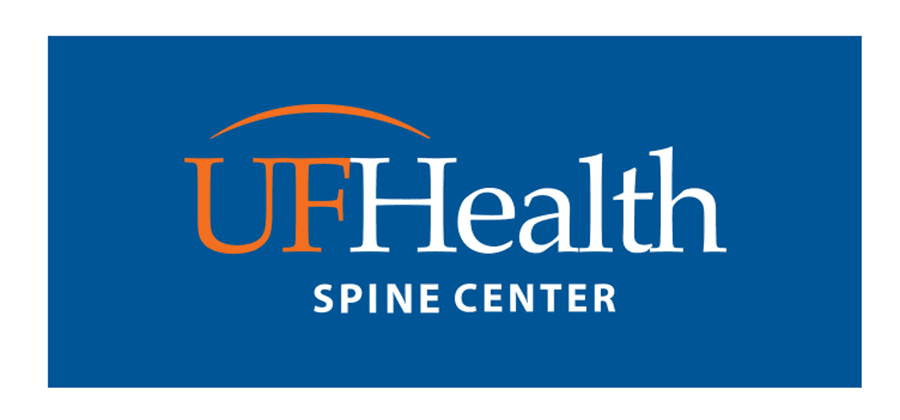October 29, 2025
Patient-Centered Approach Uses Advanced Medical Technology to Deliver World Class Spine Care
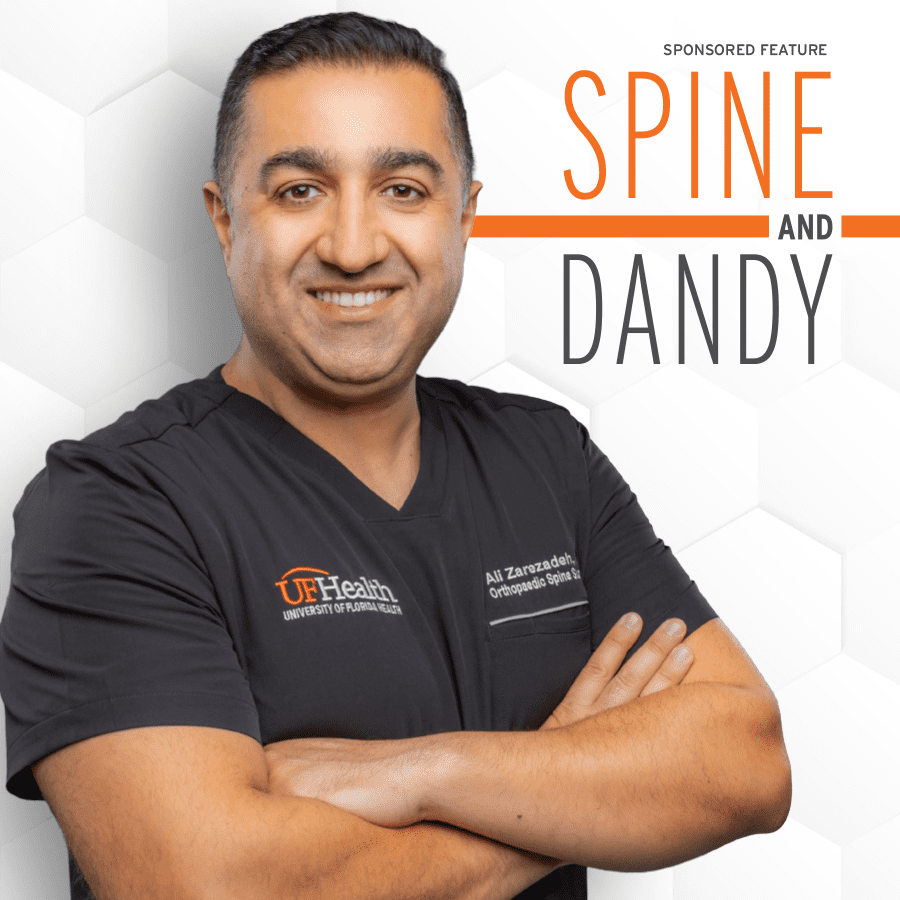
By Akers Editorial
Patient-Centered Approach Uses Advanced Medical Technology to Deliver World Class Spine Care

From nagging pain to life-altering, back pain impacts a global population—not just seniors. Back pain is one of the most common reasons for medical appointments, as those struggling with acute and chronic conditions seek relief.
Until this year, many patients with spine problems in our community traveled to larger cities in surrounding counties to get the care they desperately needed.
Thanks to the dedicated spine program that opened earlier this year at UF Health Medical Group, world class spine care is now available close to home.
Heading the spine care team at UF Health is skilled spine surgeon Ali Zarezadeh, MD, who has extensive expertise in treating both common and complex conditions.
“Using a comprehensive, yet personalized, approach allows us to provide non-surgical and surgical treatment options locally and eliminates the need for patients to travel for care,” says Dr. Zarezadeh, noting that clinical consultations and advanced spine surgery are now available at UF Health Medical Group in Lake, Sumter, Marion and surrounding counties.
A team approach is key to providing effective spine care that changes lives.
“We are a well-trained team composed of different members, from schedulers, nurses and radiology techs to physical therapists, pain management doctors and spine surgeons. All of us work together to provide a comprehensive approach to personalized care, including surgical and non-surgical options, for patients’ spine problems,” says Dr. Zarezadeh, whom patients often refer to as Dr. Z.
A University of Florida graduate, Dr. Zarezadeh did his orthopaedic surgery residency at UF from 2015 to 2020, and completed an orthopaedic oncology fellowship at UF from 2020 to 2021. This was followed by a spine surgery fellowship at the University of Colorado in Denver from 2021 to 2022.
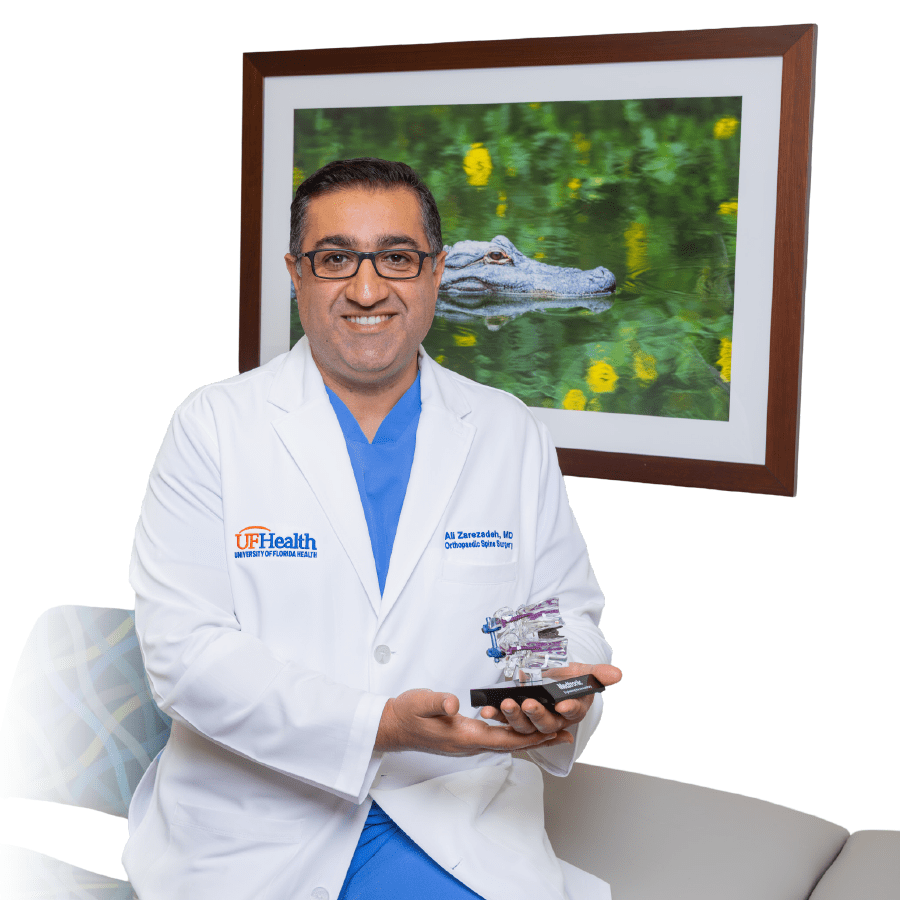
Taking advantage of technology
Many people aren’t aware of how important artificial intelligence has become in the operating room. Utilizing the latest technology has been crucial as UF Health creates a spine center of excellence.
Among the most common spine procedures being performed are spinal decompressions, spinal fusions, lumbar and cervical procedures, and microdiscectomies, which is surgery to treat herniated lumbar discs.
AI assistance in surgery planning continues to evolve and has progressed significantly in just the last few years. The use of AI has increased successful outcomes and in spine fusion surgery, it allows for highly accurate alignment according to each individual patient’s anatomy.
“We employ top-of-the-line technology called the O-arm™ surgical imaging system to execute the preplanned surgery with a high level of precision. The O-arm™ creates 3-dimensional images using a CT scan and with the help of AI. It helps us perform the surgery with more accuracy and to place hardware—including cages, screws and rods—in a very precise manner, which increases the odds of successful surgery, reduces complications and improves patient outcomes,” explains Dr. Zarezadeh.
Not only does this technology shorten time in the operating room, it also enables surgeons to safely perform more complex procedures with a reduced risk of complications. The precision of placement of hardware directly contributes to better outcomes for patients.
As with all technology, advancements are ongoing. In the recent past, some spine surgeries were not even possible or were much riskier before navigation technology became available.
“We are now using the 8th generation of the O-arm™ and stealth navigation, so it’s been evolving. The current version is the most advanced and up to date,” says Dr. Zarezadeh.
“This technology has been used across the nation in top notch spine surgery programs. We are moving shoulder to shoulder with these programs with all the technology we have available in our operating rooms at the UF Health Spanish Plaines Hospital in the Villages,” he notes.
In addition to the O-arm™, UF Health has the latest CT scans and MRI machines. This provides the ability to take full length spine x-rays from neck to pelvis, which is very important when evaluating alignment of the spine.
When back or neck pain is so debilitating that it impacts quality of life, surgery may be the answer, but of course, not everyone who makes an appointment at the spine center will require surgery. For many patients, advanced medical, interventional, minimally invasive options and addressing risk factors can drastically improve or eliminate pain without surgery.
“We provide comprehensive spine care, surgical and non-surgical treatments based on a patient’s needs. If all the non-operative measures fail, then surgery becomes an option, but most of the time we have good success treating back and neck pain without surgery by using therapy, epidural injections, and lifestyle modifications,” says Dr. Zarezadeh, adding that the UF Health team is well-versed in the latest and most effective methods currently available.
He points out that a major benefit of coming to a UF Health facility is that patients can be connected to providers across the entire UF Health system when interdisciplinary care is needed.
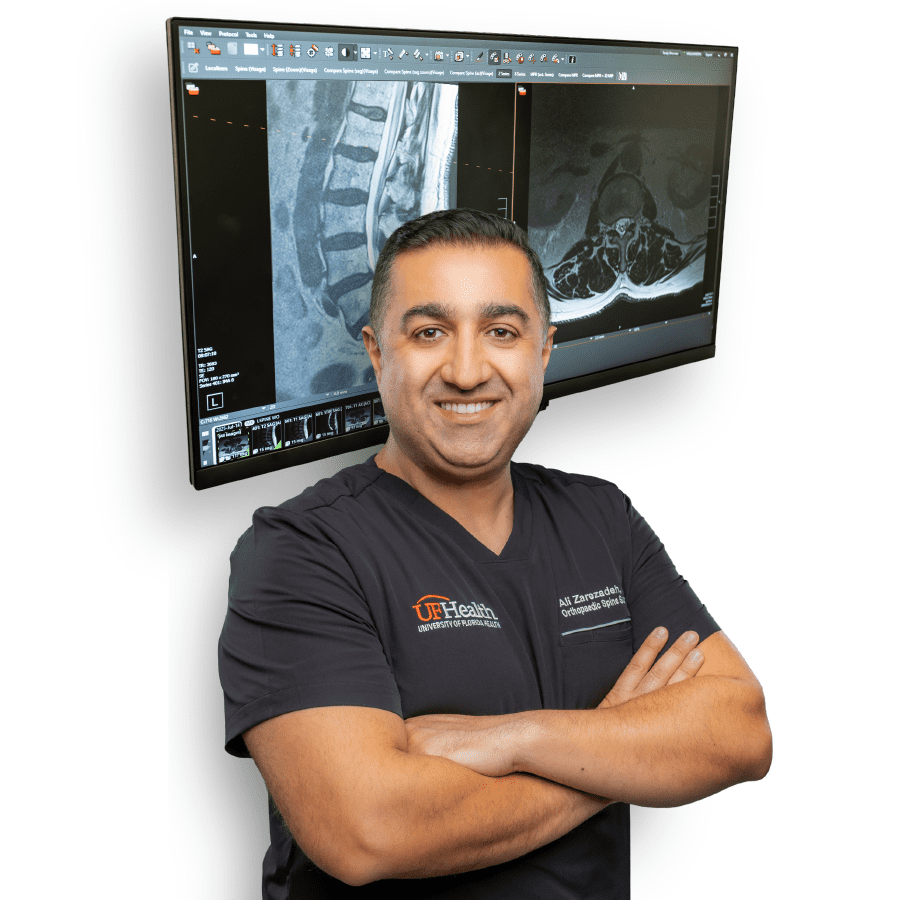
Common issues
Spine-related back or neck pain may be caused by a single incident or a complex condition. Determining the best treatment strategies to successfully address the pain at its source starts with a correct diagnosis.
“We’ve all heard horror stories about patients who have had spine surgery and still have pain, but when we can successfully identify the source of the pain and use an appropriate treatment plan to address that, the patient will have a successful outcome,” says Dr. Zarezadeh.
Patients come to UF Health for a variety of chronic and complex spine disorders, including:
- Degenerative conditions
- Spinal stenosis
- Spinal deformities
- Spinal fractures
- Spinal tumors and oncology
Among the most common spine problems Dr. Zarezadeh treats are cervical and lumbar degeneration, and compression fractures.
“Overall spine degenerative conditions are from normal wear-and-tear that happen when you live long enough. Some people are genetically predisposed to cervical and lumbar degeneration so we can’t control that, but other factors can be controlled,” says Dr. Zarezadeh.
Certain risk factors can deteriorate the condition of the spine and may cause pain and instability. Whenever possible, patients should modify those risk factors.
For example, smoking and excess weight impact the progression of spine degeneration.
“It’s always beneficial to stop smoking and address body weight. The sooner you do, the sooner you will experience benefits,” says Dr. Zarezadeh. “If you wait until your 70s or 80s to address these risk factors, you can’t really expect big changes, but if you make lifestyle changes early on, this can be a big help to spine health.”
Compression fractures in the older patient population are often associated with osteoporosis and low-energy trauma, such as falls.
Osteoporosis is more common in women because of hormonal changes after menopause, but men also experience changes in bone health as they age. Many men don’t realize this is a risk factor.
The U.S. Preventive Services Task Force recommends screening for osteoporosis to prevent osteoporotic fractures in women 65 years or older. In younger women with pre-existing risk factors, this should be done at an earlier age.
Appropriate medical treatment should follow based on test results. The current evidence is insufficient to assess the balance of benefits and harms of screening for osteoporosis to prevent osteoporotic fractures in men.
“If someone has advanced osteoporosis, appropriate treatment should be used. For low-grade osteoporosis, like osteopenia, it’s important to take vitamins, calcium and make sure to include a good level of non-contact activity exercise. Vitamin D is very helpful for bone health. Even spending 15 to 30 minutes a day outside getting sun exposure will help increase your Vitamin D levels,” says Dr. Zarezadeh.
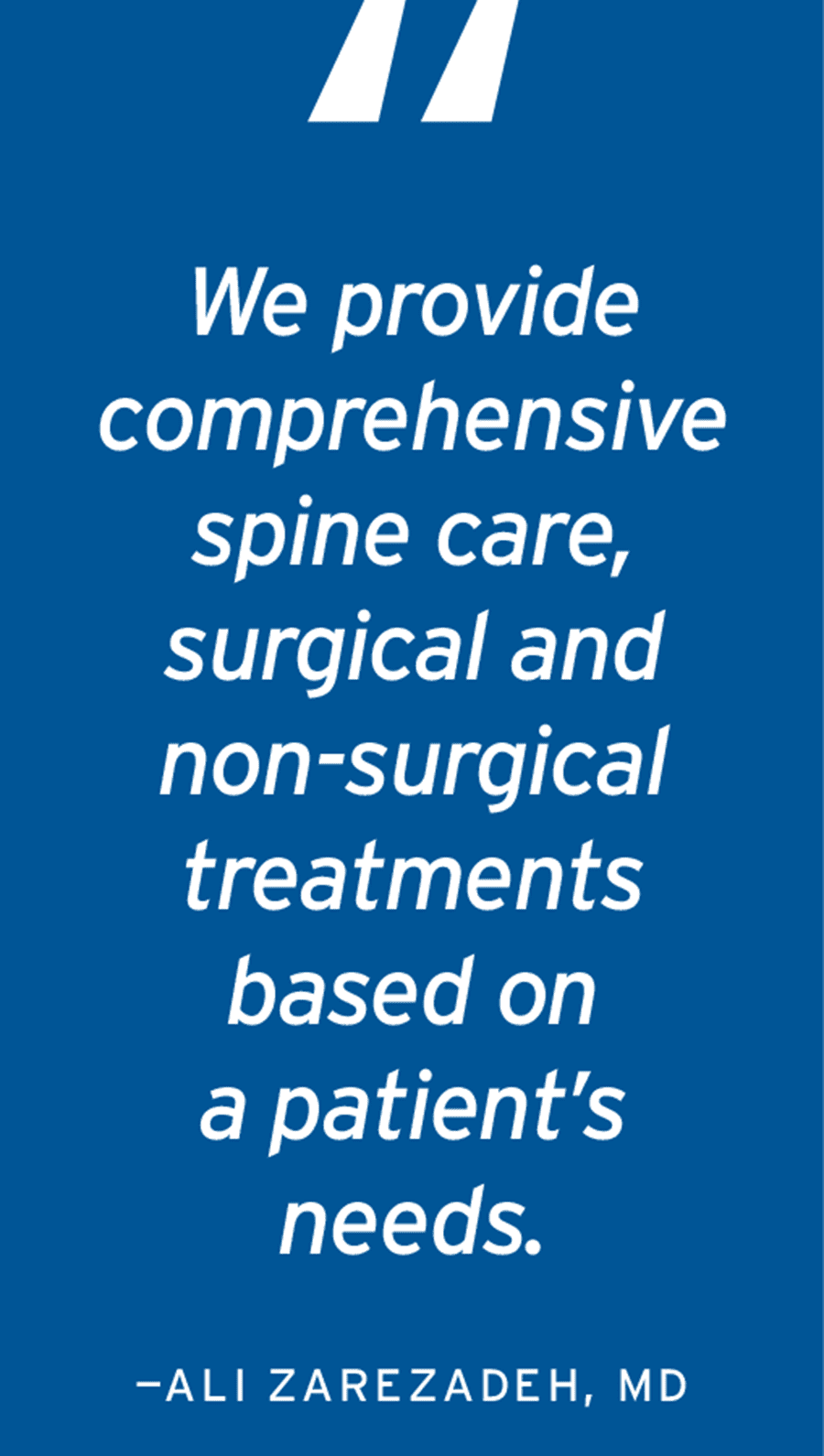
Advice to patients
Concerned about your spine health? It’s wise to take a proactive approach.
As Dr. Zarezadeh points out, we have no control over some conditions, such as infections, tumors, or accidents. That’s why it’s important to control the things we can to help preserve spine health.
- Keep moving–Maintain a level of healthy activity that promotes core strength, flexibility and proper alignment. Make daily exercise a routine. It can be as simple as walking 15 -20 minutes or swimming.
- Strengthen and stretch–Incorporate routine stretching and strengthening exercises, focusing on the legs and back, to significantly reduce the frequency and intensity of back and neck pain. A good stretching program can help prevent worsening of degenerative spine conditions.
- Maintain a healthy weight–Excess body weight causes strain on the spine and accelerates degenerative conditions, so strive to maintain a healthy weight for your height and age.
- Pay attention to posture and ergonomics–When sitting, your back should be straight not leaning forward or with shoulders hunched. Sit tall and relax your shoulders. If you work at a desk, your monitor should be at eye level. Arms and knees should be at a 90-degree level.
“I’ve had patients with advanced degenerative conditions of the cervical and lumbar spine who experienced significant improvement by having a simple routine of neck and back strengthening and stretching exercises,” says Dr. Zarezadeh. “It’s never too late to start, but obviously, the sooner you start, the more effective and preventative these measures can be.”
Book your appointment
Dealing with back or neck pain? Call the CareConnect Center to speak with patient navigators who can answer your questions and book an appointment. Same day or next day appointments are usually available.

Paid Promotional Feature
Photos by Nicole Hamel and Provided


